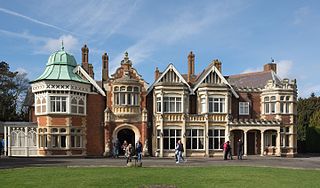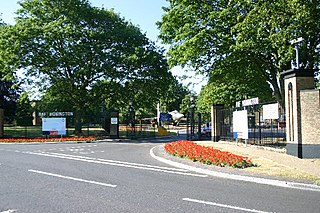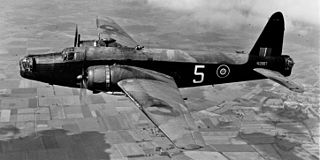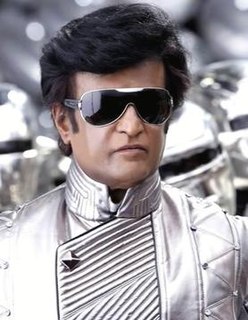
Bletchley Park is an English country house and estate in Bletchley, Milton Keynes (Buckinghamshire) that became the principal centre of Allied code-breaking during the Second World War. The mansion was constructed during the years following 1883 for the financier and politician Sir Herbert Leon in the Victorian Gothic, Tudor, and Dutch Baroque styles, on the site of older buildings of the same name.

Colossus was a set of computers developed by British codebreakers in the years 1943–1945 to help in the cryptanalysis of the Lorenz cipher. Colossus used thermionic valves to perform Boolean and counting operations. Colossus is thus regarded as the world's first programmable, electronic, digital computer, although it was programmed by switches and plugs and not by a stored program.

The V-1 flying bomb was an early cruise missile. Its official Reich Aviation Ministry (RLM) designation was Fi 103. It was also known to the Allies as the buzz bomb or doodlebug and in Germany as Kirschkern or Maikäfer (maybug).

The Avro Type 694 Lincoln is a British four-engined heavy bomber, which first flew on 9 June 1944. Developed from the Avro Lancaster, the first Lincoln variants were initially known as the Lancaster IV and V; these were renamed Lincoln I and II. It was the last piston-engined bomber operated by the Royal Air Force (RAF).

Number 99 Squadron is a squadron of the Royal Air Force which operates the Boeing C-17 Globemaster III strategic/tactical transport aircraft from RAF Brize Norton.

Thomas Harold Flowers, BSc, DSc, MBE was an English engineer with the British General Post Office. During World War II, Flowers designed and built Colossus, the world's first programmable electronic computer, to help solve encrypted German messages.

Royal Air Force Honington or more simply RAF Honington is a Royal Air Force station located 6 mi (9.7 km) south of Thetford near Ixworth in Suffolk, England. Although used as a bomber station during the Second World War, RAF Honington is now the RAF Regiment depot.

No. 460 Squadron is a Royal Australian Air Force intelligence unit active within the Defence Imagery and Geospatial Organisation (DIGO). It was first formed as a heavy bomber squadron during World War II on 15 November 1941 and disbanded on 10 October 1945 after seeing extensive combat over Europe. The squadron was a multinational unit, but most personnel were Australian. No. 460 Squadron was reformed on 2 July 2010 and is currently located in Canberra.
No. 75 Squadron of the Royal Air Force operated as a bomber unit in World War II, before being transferred to the Royal New Zealand Air Force in 1945.

Royal Air Force Debden or more simply RAF Debden is a former Royal Air Force station located 3 miles (4.8 km) southeast of Saffron Walden and approximately 1 mile (1.6 km) north of the village of Debden in North Essex, England

Heath Robinson was a machine used by British codebreakers at the Government Code and Cypher School (GC&CS) at Bletchley Park during World War II in cryptanalysis of the Lorenz cipher. This achieved the decryption of messages in the German teleprinter cipher produced by the Lorenz SZ40/42 in-line cipher machine. Both the cipher and the machines were called "Tunny" by the codebreakers, who named different German teleprinter ciphers after fish. It was mainly an electro-mechanical machine, containing no more than a couple of dozen valves, and was the predecessor to the electronic Colossus computer. It was dubbed "Heath Robinson" by the Wrens who operated it, after cartoonist William Heath Robinson, who drew immensely complicated mechanical devices for simple tasks, similar to Rube Goldberg in the U.S.

No. 214 Squadron is a former unit of the Royal Air Force.

Feltwell is a village which holds an RAF base 10 miles (16 km) west of Thetford, Norfolk, England, and is in the borough of King's Lynn and West Norfolk.

No. 466 Squadron RAAF was a Royal Australian Air Force (RAAF) bomber squadron during World War II. Formed in the United Kingdom in late 1942, the squadron undertook combat operations in Europe until the end of the war, flying heavy bomber aircraft. Following the conclusion of hostilities with Germany, the squadron began retraining to undertake operations in the Pacific against the Japanese, but the war came to an end before it left the UK. In late 1945, the squadron was disbanded.

Anthony Edgar "Tony" Sale, FBCS was a British electronic engineer, computer programmer, computer hardware engineer, and historian of computing. He led the construction of a fully functional Mark 2 Colossus computer between 1993 and 2008. The rebuild is exhibited at The National Museum of Computing at Bletchley Park in England.
Tomotaka Takahashi is a Japanese roboticist and founder of Kyoto University's ROBO-GARAGE since 2018. Takahashi creates humanoid robots known for their smooth, fluid motions and sleek appearance. Having built many humanoid robots entirely by himself, from simple concepts to production, Takahashi's designs have been featured in several art exhibitions celebrating the creation of Astroboy, Time Magazine's Coolest Inventions of 2004, and promotions for Bandai, Panasonic, and Pepsi. He has also worked with toy companies to produce relatively inexpensive robots for the hobby market, including those for Kyosho.

424 Transport and Rescue Squadron, nicknamed "Tiger Squadron", is a Royal Canadian Air Force strategic transport and search and rescue unit based at Canadian Forces Base (CFB) Trenton in the Canadian province of Ontario. The squadron is the primary provider of search and rescue response for the Trenton Search and Rescue Region, which extends from Quebec City to the Rocky Mountains, and from the Canada–United States border to the North Pole, covering an area of over ten million square kilometres in Central, Western, and Northern Canada.

Number 115 Squadron is a Royal Air Force squadron operating the Grob Tutor T1, training QFIs for the RAF's Elementary Flying Training (EFT) squadrons and the University Air Squadrons, as well as undertaking evaluation and standardisation duties.

Vickers Wellington LN514 was a Vickers Wellington bomber built in 1943 in record time, as part of a British propaganda effort during the Second World War.

Chitti is a fictional character and the primary protagonist of the Enthiran film series. The character was portrayed by Rajinikanth in Enthiran, as a cameo in Ra.One, and in 2.0. Chitti was imagined, created and developed by S. Shankar.


















